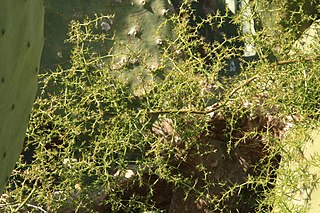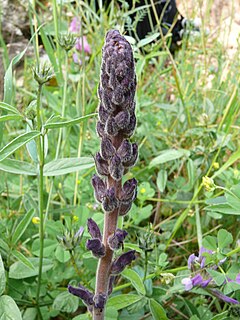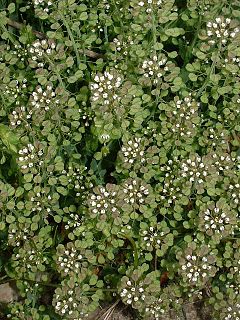
Biscutella laevigata, the buckler-mustard, is a species of flowering plant in the family Brassicaceae.

Asparagus aphyllus is a species of plants in the family Asparagaceae. They are climbing plants. Flowers are visited by the Western honey bee, Syritta pipiens, Phthiria, and Halictus.
Astragalus boeticus, the yellow milk vetch, is a species of annual herb in the family Fabaceae. They have a self-supporting growth form and compound, broad leaves.

Campanula erinus is a species of annual herb in the genus Campanula (bellflowers). They have a self-supporting growth form. Individuals can grow to 11 cm tall.

Centaurium tenuiflorum, the slender centaury, is a species of annual herb in the family Gentianaceae. They have a self-supporting growth form and simple, broad leaves. Individuals can grow to 17 cm tall.
Chenopodiastrum hybridum is a species of flowering plant in the family Amaranthaceae.
Crepis pusilla is a species of plants in the family Asteraceae.
Eleocharis ovata, the ovate spikerush, is a species of annual grass in the family Cyperaceae (sedges). They have a self-supporting growth form and have simple, broad leaves and green flowers. Individuals can grow to 1.5 feet.
Thinopyrum junceum is a species of perennial herb in the family Poaceae. They have a self-supporting growth form and simple, broad leaves. Individuals can grow to 52 cm tall.
Erodium laciniatum is a species of flowering plant in the family Geraniaceae.
Euphorbia terracina, the Geraldton carnation weed, is a species of perennial herb in the family Euphorbiaceae. It has a self-supporting growth form and simple, broad leaves. Flowers are visited by Lipotriches brachysoma, Lipotriches natalensis, Lipotriches crassula, and Nomia bouyssoui.
Hypericum australe is a species of plant in the family Hypericaceae. Individuals can grow to 24 cm tall.

Melilotus italicus is a species of annual herb in the family Fabaceae. They have a self-supporting growth form and compound, broad leaves. Individuals can grow to 0.39 m.

Melilotus segetalis is a species of plants in the family Fabaceae.

Ononis alopecuroides is a plantr species in the family Fabaceae
Orobanche clausonis is a species of plant in the family Orobanchaceae.

Orobanche lavandulacea is a species of plant in the family Orobanchaceae.
Pancratium foetidum is a species of plant in the family Amaryllidaceae.

Romulea ramiflora is a species of plant in the family Iridaceae.

Thlaspi perfoliatum is a species of plants in the family Brassicaceae.









